Bear Encounter: Tips for Trail Runners

On June 18th, 2017, young Alaskan runner Jack Cooper had a black bear encounter and was mauled by it, near a popular hiking trail just minutes after the finish of a mountain running race, as he was descending back to the parking lot. The attack shocked and devastated the local Anchorage running community and left a lot of us runners concerned about our everyday decisions to run in bear country. The details of the attack were baffling, as we usually consider it “safe” to run the trails without bear spray on race day, falsely thinking that we had safety in (loud) numbers. The path is one that I frequently run alone for training, a gentle steep climb that doesn’t seem to be an ideal territory for a bear sighting.
Frequently, bear attacks on humans occur when a bear is startled or perceives a threat to its cubs or food source. The predatory nature of Jack’s attack also concerned, because while grizzly bears have that reputation, black bears don’t usually stalk humans. And to add to the devastation, one day later another young prominent outdoor enthusiast Erin Johnson was attacked by a black bear while she was doing biology field work in another part of the state. There have been at least a dozen more reports of people having a bear encounter andunprovoked attacks in Alaska this summer. While we don’t know that has caused this bizarre increase, it’s shaken up the mountain running community greatly.
So, how can we stay safe as runners if we have a bear encounter?

Many runners carry noise-makers such as bear bells or music. Many hikers and runners will often shout things like “Hey, bear” every 30 seconds or so to alert an animal to your presence, to avoid startling any wildlife. The effectiveness of the bear bells is controversial. Many runners hit the trails with their dogs, and I’m not sure if dogs are genuinely a deterrent to attacks, or if they sometimes provoke them – it seems the jury is still out on that one.
Bear spray is well supported as something to carry while running in bear country. Bear spray is essentially a large and authoritative source of pepper spray and is a reasonably decent form of protection that is to be aimed at the bear’s face (only when you are sure that attack is imminent). Keep in mind that it’s only useful within certain distances, and in the right wind conditions. I also know some runners who will carry guns as they run (but to me and my clumsiness, that sounds disastrous!) It’s certainly only wise to carry a weapon if you are very experienced in how to use it.

Running in larger groups is generally believed to be safer than running alone in bear country. It’s still recommended that multiple people carry bear spray, even in larger groups. If you run alone, it’s wise to tell others where you are going and when you expect to return. Don’t run with headphones on the trail – it’s essential to be aware of your surroundings.
It’s wise to avoid trails near rivers in the fishing season to minimize your likelihood of an aggressive bear. Depending on where you live, it’s also wise to stick to more popular hiking trails, or trails that get you to a ridge-line quickly, where you’ll have more visibility and less likelihood of an encounter compared to running through the forest or dense brush.
It’s always smart to carry a fully charged cell phone with you, in addition to bear spray and a small first aid kit. In remote areas without cell phone reception, an emergency communication device may be helpful too.

Be prepared for any emergency scenarios and seek out first aid training classes. NOLS offers a Wilderness First Responder class that is an excellent resource for outdoor enthusiasts and runners. I took their lesson last year, and it was some of the best money I’ve ever spent. Since then I’ve already been in situations where I’ve needed to use my wilderness first aid skills and my first aid kit, too!
A proper trail running first aid kit should contain a whistle, gauze, bandages, an ace bandage, a small flexible splint, scissors, tweezers, an emergency blanket, pain killers, a tourniquet, epi-pens (if you’re allergic to insects), an emergency glucose source, matches, tape, wound closure strips, gloves, safety pins, antiseptic towelettes, and a compass or map. That may sound like a lot to carry in your hydration pack, but you’ll be grateful if you ever need to use it.
If you do happen to have a bear encounter while on a trail, you’ll want to quickly size up the situation (and stop running!) If you are between a bear and its cubs, chances are you will be attacked. If you are close to a bear eating a recent kill, such as a moose, there’s also a high risk for attack.

There are some differences between black bears and grizzly bears – for example, black bears are great at climbing trees, so you only want to climb a tree if you’ve encountered a brown bear. Grizzly bears tend to be more aggressive than black bears, and will often do a “bluff charge” where they run at you and veer off at the last minute, as a sort of “test.” In this case, you want to stand and hold your ground if being charged (which I can’t imagine doing calmly, even though I know it’s the appropriate response!) If you are under attack, the best thing to do is play dead if it’s a brown bear. If it’s a black bear, you want to fight back.
When it comes down to it, mother nature is mother nature, and we can only do so much for prevention when it comes to wild animals. That being said, it remains true that the odds of getting injured in a car crash are much higher than the odds of injury from a bear encounter. There are measures we can take as runners to be smart about preparing ourselves for potential bear risk, just as we factor in other possible trail running risks (such as lightning, bee stings, a rolled ankle, etc.). Bears are beautiful creatures, and with some extra precautionary measures, we should continue to enjoy our trails with respect for any wildlife along the way, and hopefully not to have ane bear encounter.
Latest Articles
 Is Running on a Treadmill Easier Than Running Outside?Runners have their own preferences, whether it is treadmill running, running outside on the road, or exploring trails. So...
Is Running on a Treadmill Easier Than Running Outside?Runners have their own preferences, whether it is treadmill running, running outside on the road, or exploring trails. So... Is It OK to Use Trail Running Shoes on the Road?While trail running shoes can be used on roads, especially in situations where a runner encounters mixed terrains or pref...
Is It OK to Use Trail Running Shoes on the Road?While trail running shoes can be used on roads, especially in situations where a runner encounters mixed terrains or pref... How to Fix Sore Quads After Running?Rest, ice, gentle stretching, and over-the-counter pain relievers can help soothe sore quads after running. Also, ensure ...
How to Fix Sore Quads After Running?Rest, ice, gentle stretching, and over-the-counter pain relievers can help soothe sore quads after running. Also, ensure ... 10 Fruits With The Most Electrolytes to Replace Sports DrinksThese fruits are high in electrolytes such as potassium, magnesium, and calcium, essential for hydration, muscle function...
10 Fruits With The Most Electrolytes to Replace Sports DrinksThese fruits are high in electrolytes such as potassium, magnesium, and calcium, essential for hydration, muscle function...

